Church of the Holy Sepulchre - Jerusalem, Israel
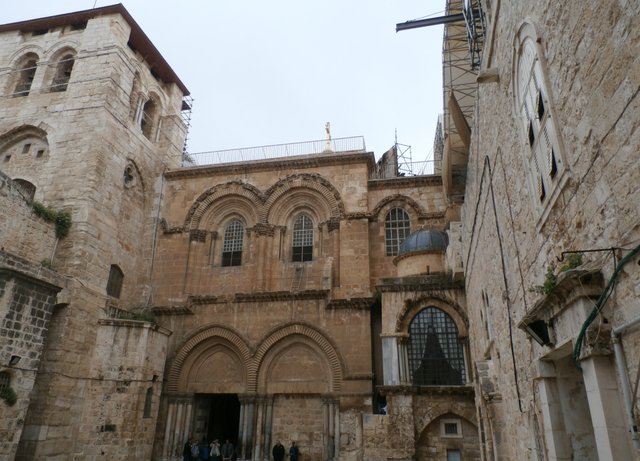
I have been recounting my trip to Israel in chronological order. The timing of this article couldn't have been better. The Church of the Holy Sepulchre made international news yesterday, when scientists released data confirming that the tomb believed to be the burial place of Christ coincides with historical records indicating that the tomb was encased around 326 AD by Constantine, whose mother Helena visited the Holy Land on a mission to locate places significant in the Gospels.
Scientists were able to use a method called optically stimulated luminescence to date sediment uncovered during ongoing reconstruction at the tomb, which has become weakened over the centuries. The sediment came from a limestone bed that may have once held the body of Jesus. The sediment dated to 345 AD, which places it almost exactly on the dates held by historical accounts for the entombment. The church itself was built in the Byzantine era, destroyed, and rebuilt by the Crusaders. The tomb had previously only been dated to the most recent construction during the Crusader era.
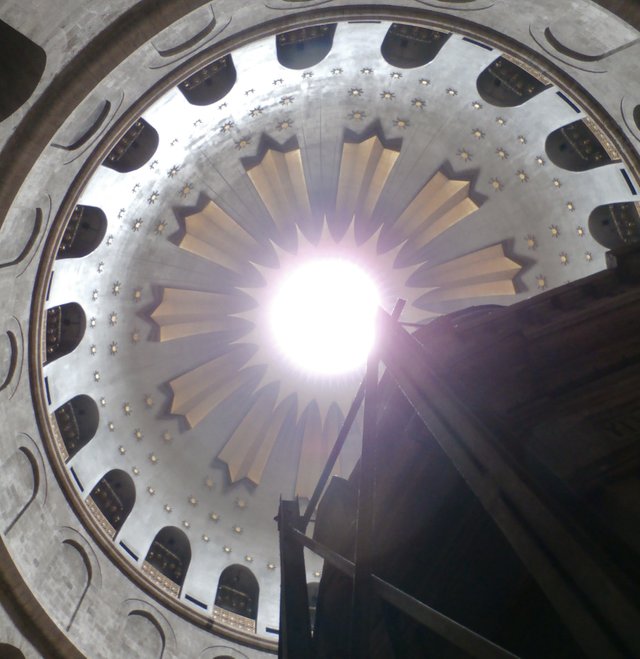
The tomb was already under reconstruction when I visited last year, as evidenced by this scaffolding that you can see in the photo I took of the chapel roof. It is amazing to me that the timing of this discovery allows me to talk about this amazing church with a current frame of reference. In Bethlehem, the place of Christ's birth was easy for Helena to locate, because the Romans put a Roman temple over the place where Christians were already gathering to worship as a way of desecrating it. Instead, they marked it. Interestingly, the Romans also had built a temple on this location prior to its discovery as the likely location of Christ's tomb in the early fourth century.
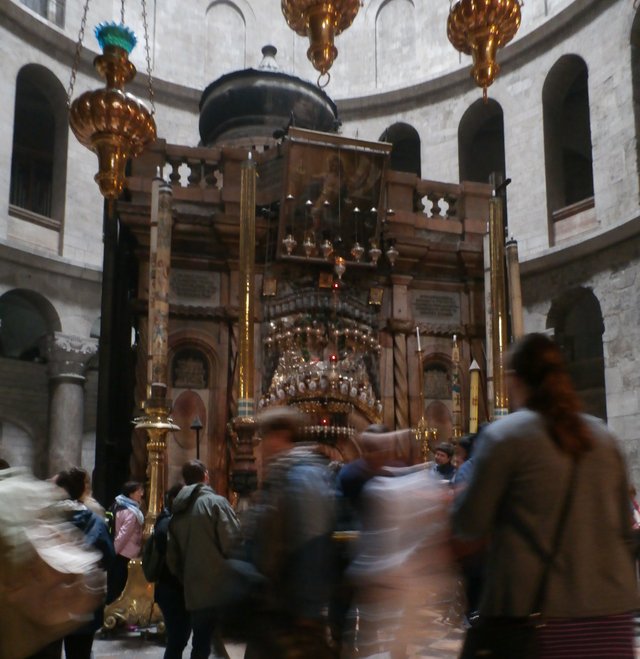
The sepulchre itself is an almost gaudily adorned structure inside the main chapel. The lines to enter the sepulchre can be long. So be prepared to stand for a while if you wan to enter the inner chamber. My wife and I waited. We went off season, so the wait was only about an hour. But I would imagine during specific holy days and peak tourist season, the lines may be unbearable. I can't say the line was worth the wait, as you are really standing in an area above the actual burial chamber. And God is not buried there. So it is more of a shrine than anything. But it was interesting to visit.
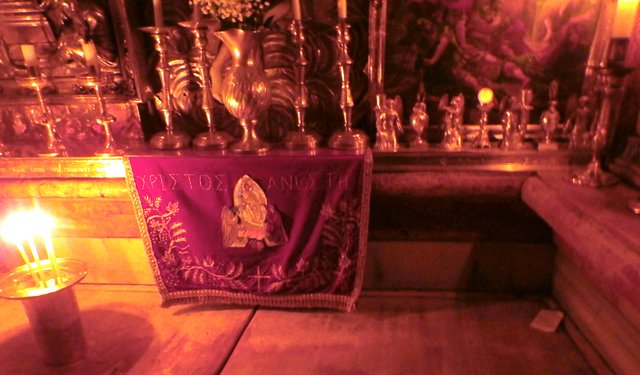
The lighting was really poor, so I apologize for the quality of this photo. As with all my photos, I use a regular point and shoot camera. I am not a photographer. So my photos are nowhere near as good as many of the folks who post their travel photos. But you get the idea about the interior of the sepulchre from this photo.
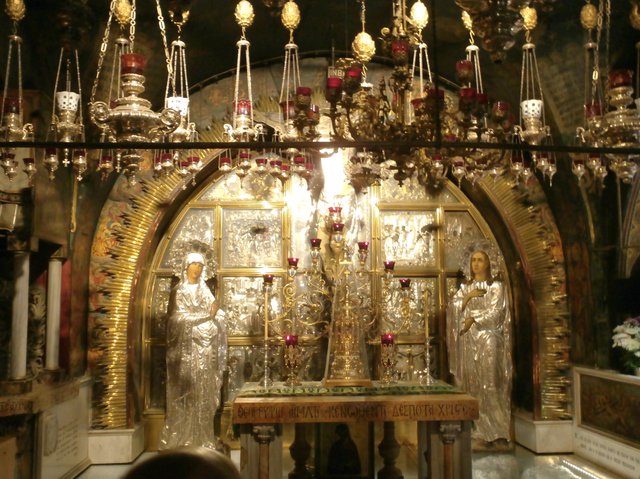
The other significant location within the Church of the Holy Sepulchre is Calvary. This is the location that marks where Jesus was hung on the cross. Again, this site sits above the actual location. You have to walk up a set of stairs to get to Calvary. There can be long lines here, as well, but not quite as bad. The stairway is steep and narrow. Below the altar in this photo is an ornate hole in the floor. Some people place their hands into this hole. I guess it is a way of reaching down toward the actual place where the cross once stood. I love the history, but I'm not really into iconic representations, so I took my turn looking at the altar and then let the next person have their space. I really appreciated the incredible art in this area. The walls and ceilings are painted and there are a host of lanterns and gilded items adorning the area.
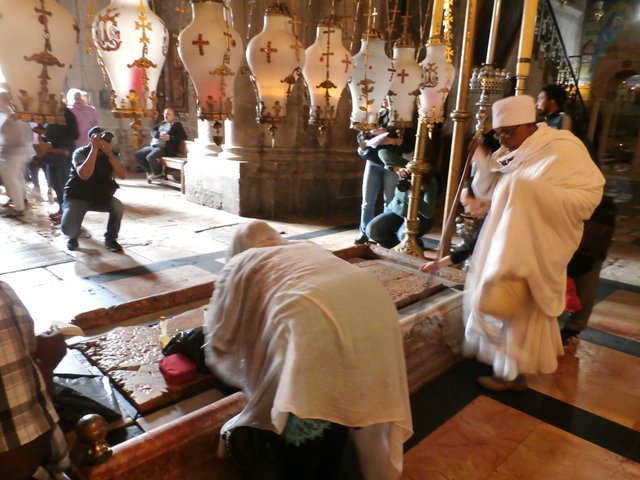
Below the stair leading up to Calvary is a marble slab placed in the floor, within another ornate receptacle. This stone is called the Stone of Anointing but is not the actual stone upon which Christ's body was prepared for burial. It is more of a representation. Pilgrims come to this stone and kneel, kiss the stone and often place objects upon it for blessings. The current stone has only been their since nineteenth century and the practice only dates to the thirteenth century.
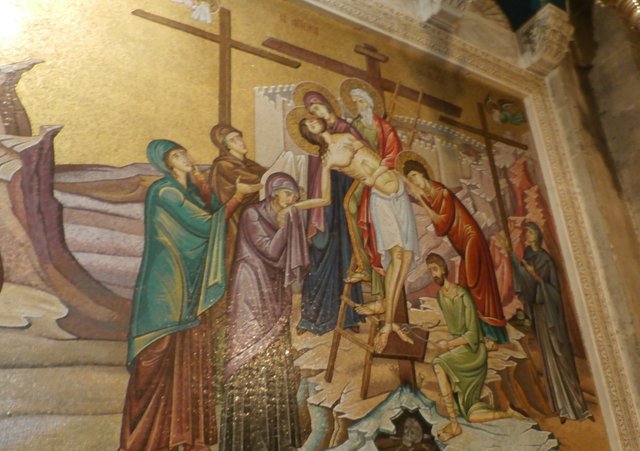
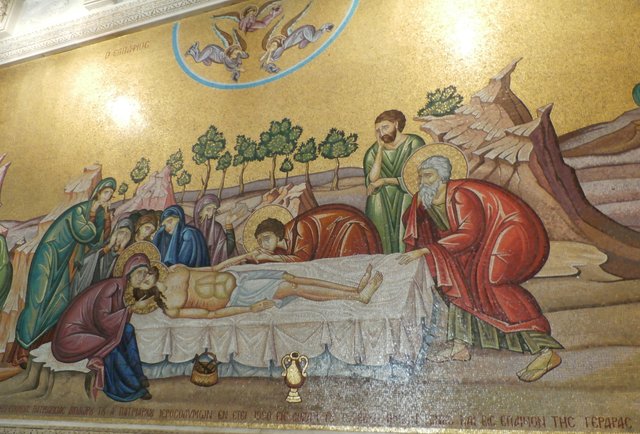
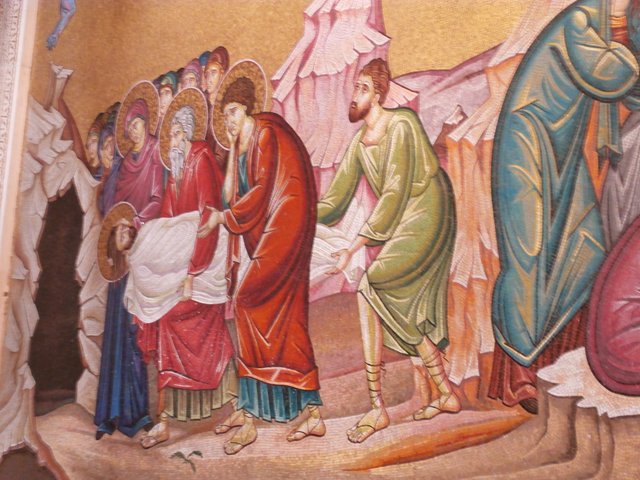
Behind the Stone of Anointing is a series of three Greek murals that depict Christ being lowered from the cross, his body being dressed in burial clothes and being placed inside the tomb.
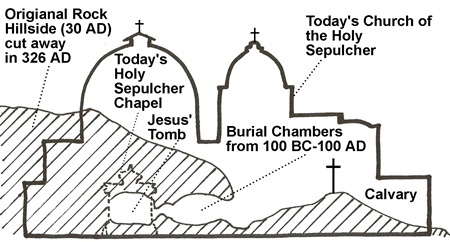
To provide some perspective on the locations within the Church of the Holy Sepulchre, I have borrowed this illustration from Generationword.com. This illustration shows an overlay of the current church with the location of the tomb and cross at the time of Jesus' crucifixion. The illustration is helpful if you ever get a chance to visit as the entire area is now inside the connected church structures.
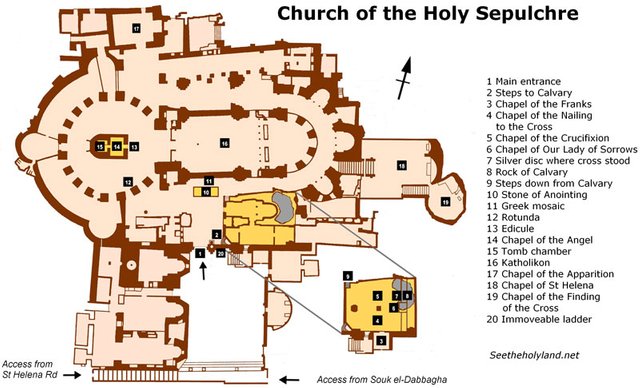
This map also is included to help provide some perspective on the layout of the church. The map is taken from seetheholyland.net. If you look at my photo of the entrance into the church and you look at this map, you can see that neither look like the normal way we enter a church. This was not the original entrance. If you look to the east, you can see that the church actually appears to face that direction. The Roman Cardo runs along that side of the church. The entrance used to come into the church from that direction.
In my last post, on the Via Dolorosa, I talked about the nine Stations of the Cross along the route to Calvary. I also mentioned that there were five more Stations of the Cross within the *Church of the Holy Sepulchre. These stations are:
- Jesus was stripped of his garments at the entrance to Calvary. Which is immediately to the right as you enter from the current entry into the church.
- The Roman Catholic chapel up the stairs to your right at Calvary. This is where Jesus was nailed to the cross.
- The Greek Orthodox Altar beside the Roman Catholic chapel at Calvary. This is where Jesus died on the cross.
- To the left of the main altar is where Jesus was removed from the cross.
- The tomb is the final Station of the Cross.
I hope you enjoyed reading about the Church of the Holy Sepulchre and the exciting developments providing concrete evidence that places the date of the Roman entombment in the same time frame as historic accounts place it. Be sure to check out my other adventures in Israel!
A Christian Guide to Israel
Hotels
Cinema Hotel Tel Aviv, Israel
Ron Beach Hotel, Tiberias, Israel
Prima Park Hotel Jerusalem, Israel
Attractions
Caesarea National Park Caesarea, Israel
Mount Precipice Mount Kedimum, Israel
Sea of Galilee Boat Ride Tiberias, Israel
Yigal Alon Museum (Jesus Boat) Ginosar, Israel
Capernaum, Israel
St. Peter’s Restaurant Kinneret, Israel
Caesarea Phillipi Banias, Israel
Gadot Lookout and Memorial Golan Heights, Israel
Jordan River Baptismal Site Yardenit, Israel
Beit She’an National Park Beit She’an, Israel
Mount of Olives, Jerusalem, Israel
Garden Tomb Jerusalem, Israel
Western Wall Jerusalem, Israel
Western Wall Tunnels Jerusalem, Israel
Bethlehem New Store Gift Shop
Pools of Bethesda Jerusalem, Israel
Via Dolorosa Jerusalem, Israel
Israel Museum, Jerusalem, Israel
Yad Vashem, Jerusalem, Israel
House of Caiaphas the High Priest, Jerusalem, Israel
The Upper Room, Jerusalem, Israel
Tomb of King David, Jerusalem, Israel
Masada National Park, Masada, Israel
The Dead Sea, Masada, Israel
Churches
Discalced Carmelite Monastery Muhraqa, Israel
Basilica of the Annunciation Nazareth, Israel
St. Peter’s Church Capernaum, Israel
Church of the Multiplication Tabgha, Israel
Church of the Beatitudes Tabgha, Israel
Church of All Nations Jerusalem, Israel
Church of Saint Anne Jerusalem, Israel
Church of the Holy Sepulcher, Jerusalem, Israel
Church of the Nativity, Bethlehem, West Bank
Unless otherwise indicated, these photos are my own. They may be used with permission.
Wow @coldsteem, very complete post! Plenty of interesting information and photos. To visit Jerusalém is a dream I want to live someday. I also write about trips, so I invite you to visit my blog.
Nice blog, very informative! It must feel like looking back in time! So it's not allowed to visit the actual tomb?
To be honest, I’m not exactly sure. I think this is allegedly it. But it’s not a cave, it’s a man made structure like a mausoleum. So I’m guessing the cave may be beneath?
You have received an upvote from STAX. Thanks for being a member of the #steemsilvergold community and opting in (if you wish to be removed please follow the link). Please continue to support each other in this great community. To learn more about the #steemsilvergold community and STAX, check this out.
It's very interesting, thanks coldsteem
Congratulations, Your Post Has Been Added To The Steemit Worldmap!
Author link: http://steemitworldmap.com?author=coldsteem
Post link: http://steemitworldmap.com?post=church-of-the-holy-sepulchre-jerusalem-israel
Want to have your post on the map too?
Add the following inside your post:
!steemitworldmap xxx lat yyy long description d3scr
(replace xxx and yyy with latitude and longitude)